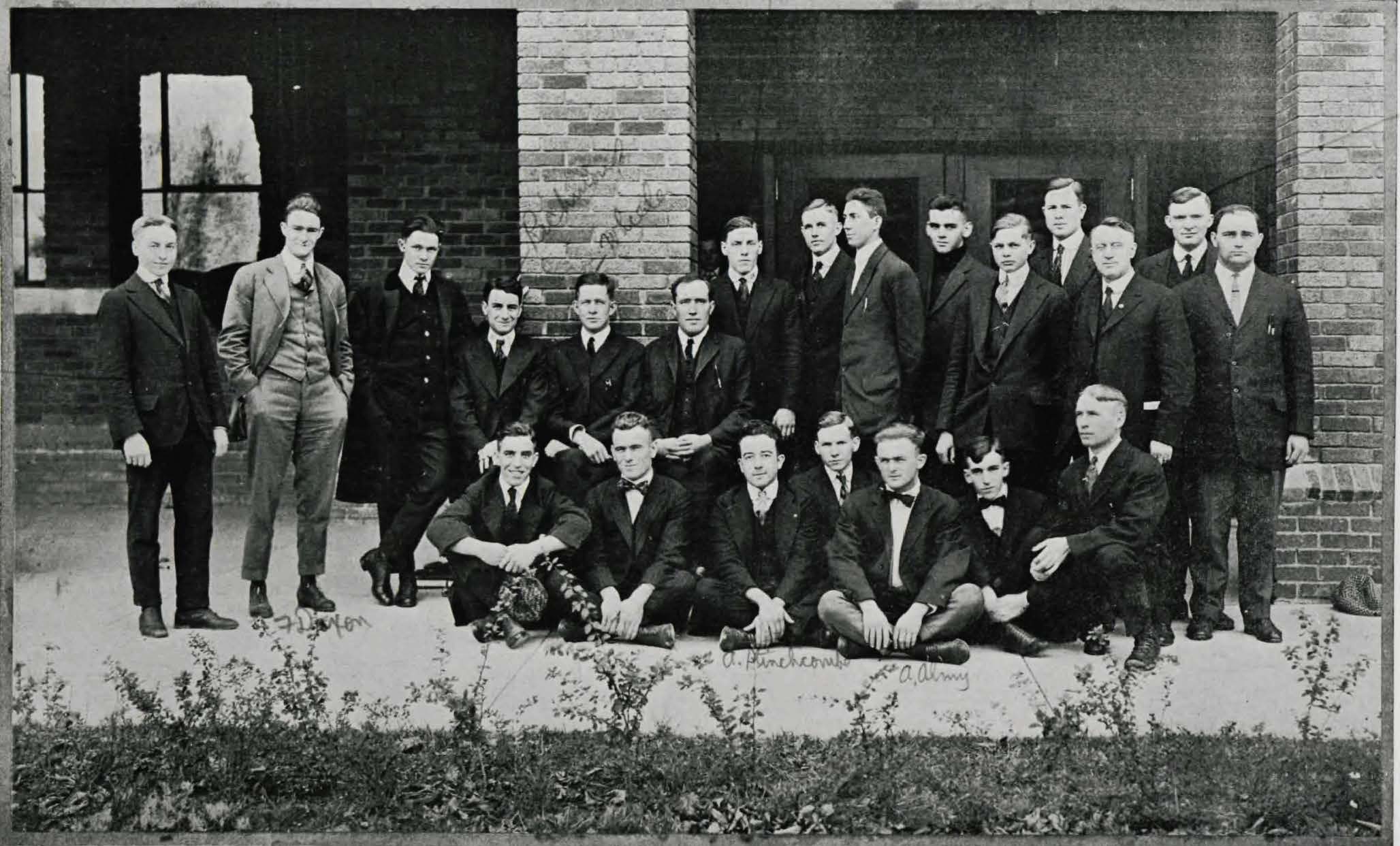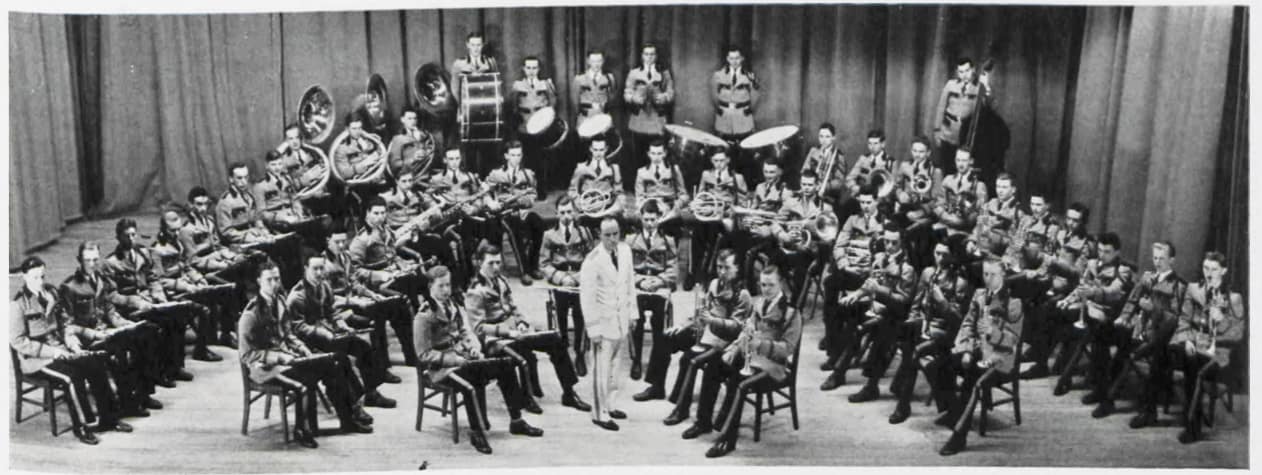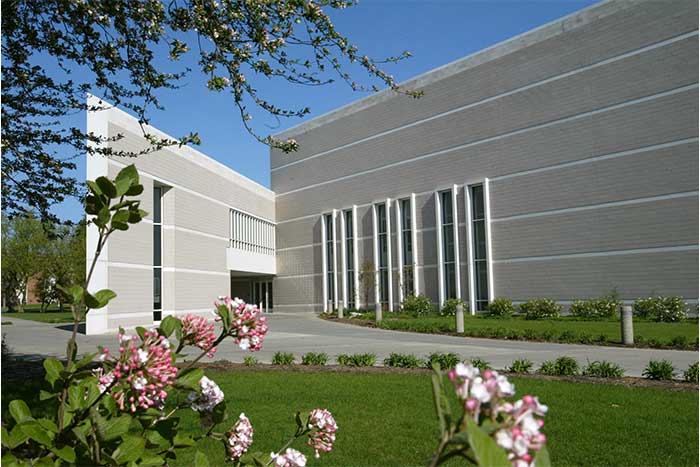School of Music History
The First 25 Years: 1892-1917
As documented from earliest records, music has been integral to CMU, first as a component in teacher training that grew from lower-level vocal music electives to a sequence of courses across the full program of study. Music quickly grew into a separate department with its own faculty and as an outlet for health and all-campus events.
1892 Central Michigan Normal School and Business Institute opens: focus on teacher training
1893 Dropped "and Business Institute" from the name
1896 Second Annual Announcement of the Central Michigan State Normal School:
Vocal music offered as a teacher training elective in the first 2 years.
1897 Catalog lists Public School Music faculty positions separately from Conservatory of Music faculty teaching "Piano, organ, violin, mandolin, voice, harmony, musical history, theory, chorus, orchestra, elementary and public school music."
1899 Year Book and Circular of Information:
Vocal music offered at all teacher training levels, first as reading and "voice culture" then teaching methods; conservatory enrollment approaches 100.
1900 Bulletin, Volume 1 Number 1 first lists a Department of Music with a purpose "to prepare teachers to teach music in the primary and grammar grades of the public schools of the State." Offerings include Elements of Vocal Music I and II for "sight-reading and the cultivation of the voice and ear," 12-week Rural School Course with same purpose, 12-week Teachers' Course In Music focused on knowledge of music and teaching of singing in grades 1-8, and Chorus "for morning exercises, special occasions, etc."

The Second 25 Years: 1918-1942
In a period marked by two world wars, music at CMU grew in numbers, types, and sizes of music ensembles and in total participation. Ensembles varied in how they were offered and who could be a member, whether as a student in a course or as a member of a music or campus-wide student organization.
1918 Central Normal Band established under U.S. Students' Army Training Corps; interest waned after WW I.

1923 Listed as Music Organizations are The Normal Chorus of about 100 singing oratorio, operatic, and operetta works, 16-voice Girls' and Men's Glee Clubs, and The Normal Orchestra of "Every students…who can play some orchestral instrument" to appear in Chorus and other programs. Listed under Student Organizations are a first-ever 22-member Normal Band organized by J. H. Powers, head of the Music Department, to be "one of the colorful features" of football and other athletic events.

1926 Women are allowed to join the band
1927 Name change to Central State Teachers College
1934 Ensembles are listed as student organizations. The Band (Band Club in subsequent years) reorganizes to serve a social function and to cooperate with other extra-curricular organizations. The Choral Union comprises a 50-voice A cappella Choir, Girls' Glee Club, Men's Glee Club, quartets, and a newly-formed Madrigal Singers. Orchestra "of symphonic proportions” (40+) is divided into string orchestra and woodwind and brass ensembles.

1939 Graduate courses offered as an extension of the University of Michigan;
1941 Name change to Central Michigan College of Education
Past the Half-Century Mark: 1943-1967
Reflecting a scope broadened beyond CMU’s teacher-education origins, music grew in new degree, course, and ensemble directions from organ and church music to small popular music groups. By the 75th anniversary, the music department expanded into new facilities, new graduate offerings, and new accreditation status.
1951 Installation of a new electric Baldwin organ in Warriner Auditorium.
1952 Organ is first listed for private study along with voice and orchestra and band instruments.
1954 First Graduate Bulletin and launch of "independent graduate programs" in elementary education. Madrigal Singers reformed, and accompany the Concert Choir on tour.

1955 Name change to Central Michigan College with diversified programs; Men's Glee Club renamed the "Singing Chippewas."
1957 Dixieland band "The Beavers" forms.
1959 Name change to Central Michigan University suggesting a more "universal" education
1960s Electronic or experimental music is introduced to campus in a 1961 art exhibit, 1962 Arts Festival, 1964 summer Arts Course concert, and 1966 music lecture demonstration.
1960 Graduate music courses in composition, research project in music education, voice, oboe, clarinet, cornet or trumpet, French horn, trombone or baritone. The Music Department moves into Keeler Union (later
renamed Powers Hall, after J. Harold Powers). Prior to this time, classes and rehearsals were held in Old Main, Warriner Hall, and in military barracks-style "Sheep Sheds," located where the Northwest Quad now stands. Music education classes and faculty
moved to Ronan Hall with education. "Swingin' Chips" dance band forms.
1961 Graduate music courses in functional music, music reading, form analysis, composition, symphonic literature, contemporary composers and styles; music for children, junior high school music, musical growth through listening activities, choral conducting, instrumental conducting, philosophy/history of music education, organization of school music, individual research in music materials, research project in music education, voice and instrumental lessons including strings.

1963 CMU became an accredited institutional member of the National Association of Schools of Music (NASM). Dance band "Swinging Chips" becomes Jazz Lab 1, soon followed by brass, percussion, trombone and other small
"choirs" and ensembles.
1964 Master of Music in Music Education and Supervision with a separate list of music courses available to other graduate students based on semester hours in music.
Closing a First Century: 1968-1992
Joining a continued growth in graduate offerings, undergraduate music degrees expanded in type and number. Jazz became a stronger fixture of the department, and small specialized ensembles grew as offerings that bridged campus and community.
1970 Degrees expand to music minor, BM (in orchestral instruments, organ, piano, voice, theory/composition), BME, BS, BSE, BA, BSEd with music concentration, MA, and MM.
1970s Music annexes portions of Barnes Hall, which also housed music record and tape collections; music education classes and faculty remain in Ronan Hall with education.
 |  |
1971 An electronic music and composition course is included in summer music camp for high school students.
1972 Masters of Music degree in performance added to music education and supervision; jazz studies, string performance, and music literature minors added to the BME. Kney organ build for Powers Recital Hall.
1973 First annual Jazz Festival.
1975 A history of Vocal Jazz Ensemble begins at the renamed Jazz Weekend and is featured in concert again in Spring 1978; an eight-member VJE forms Spring 1984 and is featured again in Spring 1985 as Vocal Jazz Quartet;
in Spring 1992 a “rejuvenated” VJE performs with Women’s Chorus and Barbershop Quartet; a graduate student leads a VJE Spring 1998; and a new faculty-directed Vocal Jazz Ensemble performs with Jazz Lab 1, Women’s Chorus, and
in the community 2010-2013.
1976 "Studio Twelve" jazz orchestra is featured at campus and community events for over a decade, focusing on stylistic jazz, new works, and improvisation skills.
1981 Central Air Jazz Band joins Jazz Lab I and Studio Twelve in meeting growing student interests, lasting 19 years (2000).

1986 Barbershop chorus "Central Harmony" forms with membership open to university and community, out of which quartets also form, lasting over a decade.
1988 Bulletin lists BM in orchestral instruments, piano, organ, voice, theory/composition, church music; BA/BS in instrumental, keyboard, and vocal performance, music literature, and theory; minors in instrumental, keyboard, vocal, theory, music history; BME with instrumental, choral, keyboard/instrumental, keyboard/choral concentrations; BS in Education with instrumental, choral, and general music majors and choral or general music minor. Music Synthesis course is established for music majors and minors and any interested CMU students with adequate piano skills.
1989 Friends of Music funds “the best in the state” MIDI Center of electronic synthesizer work stations.
1990 Instrumental jazz studies and keyboard/voice church music concentrations added to the BA/BS; String Sinfonia offers Saturday morning classes for pre-college students.
1992 Electronic music is first presented on MIDI wind controllers, percussion, and synthesizers.
Into A New Century: 1993-present
With a new century came a new name—School of Music—and new building to house all music faculty and music-related holdings in one place for the first time. Marking a period a stability, changes reflect a continuation and culmination of previous trends in expanded degree offerings and ensembles. Music for elementary teacher training was reduced from a pair of courses for all majors and optional general music minor to a single course, with all music education major and minor programs under the School of Music.
1993 Phase One again creates a third jazz band at CMU “to give more students the opportunity to play jazz,” lasting six years (1999).
1995 CMU Department of Music changed to School of Music.

1997 New music building features windows to illuminate maple against concrete and limestone, a chamber music hall, a concert hall with Casavant pipe organ as centerpiece, rehearsal rooms sized by ensemble type, and more than double the equipment and space for electronic music.
1998 Inception of OPUS, an annual fund-raising event for the School of Music.
1999 Interdisciplinary music theatre degree implemented.
2000 Jazz Central bridges the disbanding of Phase One and Central Air, maintaining a second large jazz ensemble to Jazz Lab I. Chamber ensembles Central Wails Saxophone Orchestra and JazzBone refocus the tradition of trombone, flute, clarinet, and other instrument-specific “choir” ensembles.
2001 Debut of E-Band, a “new ensemble composed of faculty members and students playing electronic instruments;” lasting to the 2005-2006 school year.
2003 Vocal a cappella groups form as campus-wide student organizations: all-male "Fish 'n' Chips" and all-female "On the Rox," and co-ed "Central Harmony" two years later.
2004 Masters of Music is offered in performance, music education, composition, conducting, & piano pedagogy. Contemporary Compositional Techniques course is added for upper-division and graduate music majors, “with
particular attention paid to electronic music.” President’s Research Investment Fund grant to establish a CMU International Center for New Music to commission new works.
2005 Barbershop chorus returns to campus, renamed "MountainTown Singers," and wins first place in international competition within four years.
2009 General Music Option on the Music Education Major elevates previous general music minor to equal status with Choral Option and Instrumental Option.
2010s A period of stable degree programs, new UP music courses such as Music and the Mind, and peak enrollments that then begin to decline; an elective Performance Anxiety Management course and annual school-wide workshop events address this rising problem.
2020s Revision of core theory/history courses with popular, common practice period, post-tonal music, and other options such as songwriting customized to different music degrees; expansion of UP music offerings such as Music and Cartoons.
2022 Commercial Music is introduced as a new interdisciplinary major.
